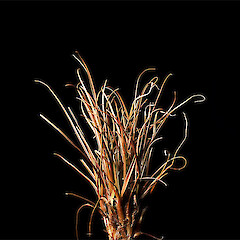Carex petriei
Common name
Petrie’s sedge
Synonyms
None
Family
Cyperaceae
Flora category
Vascular – Native
Endemic taxon
Yes
Endemic genus
No
Endemic family
No
Structural class
Sedges
NVS code
The National Vegetation Survey (NVS) Databank is a physical archive and electronic databank containing records of over 94,000 vegetation survey plots - including data from over 19,000 permanent plots. NVS maintains a standard set of species code abbreviations that correspond to standard scientific plant names from the Ngä Tipu o Aotearoa - New Zealand Plants database.
CARPTR
Chromosome number
2n = 60-62
Current conservation status
The conservation status of all known New Zealand vascular plant taxa at the rank of species and below were reassessed in 2017 using the New Zealand Threat Classification System (NZTCS) – more information about this can be found on the NZTCS website. This report includes a statistical summary and brief notes on changes since 2012 and replaces all previous NZTCS lists for vascular plants.
Please note, threat classifications are often suggested by authors when publications fall between NZTCS assessment periods – an interim threat classification status has not been assessed by the NZTCS panel.
- Conservation status of New Zealand indigenous vascular plants, 2017 . 2018. Peter J. de Lange, Jeremy R. Rolfe, John W. Barkla, Shannel P. Courtney, Paul D. Champion, Leon R. Perrie, Sarah M. Beadel, Kerry A. Ford, Ilse Breitwieser, Ines Schönberger, Rowan Hindmarsh-Walls, Peter B. Heenan and Kate Ladley. Department of Conservation. Source: NZTCS and licensed by DOC for reuse under the Creative Commons Attribution 4.0 International licence.
2017 | Not Threatened
Previous conservation statuses
2012 | Not Threatened
2009 | Not Threatened
2004 | Not Threatened
Brief description
Densely tufted, erect to loosely spreading small red to dark wine-red tussocks; leaves cirrhose at tips. Spikes 3–6, very dark red-brown; styles 3; utricles very dark red to almost black though paler towards the apex and base.
Distribution
Endemic. North, South and Stewart Islands. In the North Island scarce, known only from the Moawhango area (where it may now be extinct). In the South Island throughout except, apparently, Westland. Scarce on Stewart Island/Rakiura.
Habitat
A species of montane to subalpine river flats, stream sides, and lake, pond and tarn margins. It may also be found in seepages within tussock grassland.
Wetland plant indicator status rating
Information derived from the revised national wetland plant list prepared to assist councils in delineating and monitoring wetlands (Clarkson et al., 2021 Manaaki Whenua – Landcare Research Contract Report LC3975 for Hawke’s Bay Regional Council). The national plant list categorises plants by the extent to which they are found in wetlands and not ‘drylands’. The indicator status ratings are OBL (obligate wetland), FACW (facultative wetland), FAC (facultative), FACU (facultative upland), and UPL (obligate upland). If you have suggestions for the Wetland Indicator Status Rating, please contact: [Enable JavaScript to view protected content]
FAC: Facultative
Commonly occurs as either a hydrophyte or non-hydrophyte (non-wetlands).
Detailed description
Densely tufted, erect to loosely spreading small red to dark wine-red tussocks. Culms 60–350 × 0.5–1 mm, glabrous, terete or flattened; basal sheaths light brown, occasionally red to reddish brown. Leaves usually slightly > culms, 0.5–2 mm wide, pink or greenish red, lamina narrow-linear, concavo-convex, grooved on the back, showing 2 conspicuous nerves on the upper surface, margins scabrid, apex acute, curled and twisted when dry; sheaths very wide, about 3 times width of lamina. Spikes 3–6, very dark red-brown, more or less approximate, though usually with the lowest more distant on stiff, erect peduncles; terminal spike male; remaining spikes female, usually with a few male flowers above, 1–30 × 3–6 mm. Glumes < or sometimes > utricles, rather pale brown, chartaceous-membranous becoming chaffy, margins lacerate, apex acute or with the midrib prolonged into a long scabrid awn. Utricles 2.5 × 1.5 mm, plano-convex, turgid, very dark red to almost black though paler towards the apex and base, sometimes light brown throughout, smooth of faintly nerved; beak slightly > 0.5 mm long, usually cream. Stigmas 3. Nut 1.5 mm long, dull brown, trigonous, oblong-obovoid.
Similar taxa
A distinctive species well marked by the leaves broad sheathing base and their fine, curled and twisted apices, pale coloured glumes, and dark purplish-brown to almost black, narrow-ovoid or elliptic turgid utricles. In specimens with dark coloured utricles the bright red lateral nerves are particularly distinct. Carex petriei is not obviously closely allied to any of the other New Zealand species but is perhaps most similar to C. traversii Kirk and C. druceana Hamlin, species from which it is easily distinguished by the very broad bases of the leaf sheaths, and by the lowest most female spikes borne on stiffly erect peduncles.
Flowering
October–January
Flower colours
Green
Fruiting
October–May
Life cycle
Nuts surrounded by inflated utricles are dispersed by granivory and wind (Thorsen et al., 2009).
Propagation technique
Easily grown by division of whole plants and from fresh seed. A very attractive dark red sedge ideal for a sunny damp situation in most soil types. Has proved remarkably adaptable and drought tolerant though it dislikes excessive humidity.
Etymology
carex: Latin name for a species of sedge, now applied to the whole group.
petriei: Named after Donald Petrie (1846 -1925), Scottish born Otago botanist
Attribution
Description adapted from Moore and Edgar (1970)
References and further reading
Moore LB, Edgar E. 1970. Flora of New Zealand, Volume II. Indigenous Tracheophyta: Monocotyledones except Gramineae. Government Printer, Wellington, NZ. 354 p.
Thorsen MJ, Dickinson KJM, Seddon PJ. 2009. Seed dispersal systems in the New Zealand flora. Perspectives in Plant Ecology, Evolution and Systematics 11: 285–309.









